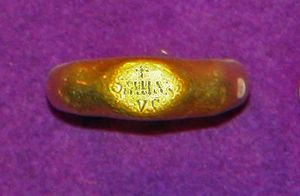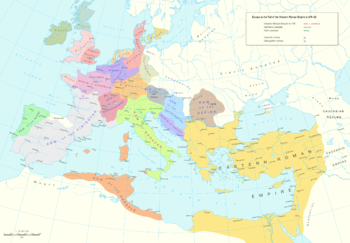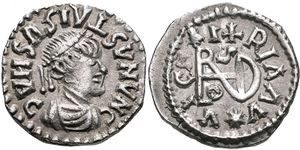گپي

الگپي (Gepids ؛ لاتينية: Gepidae, Gipedae) كانوا قبيلة جرمانية شرقية. وكانوا أقارب لصيقين، أو جزء من القوط.
They are first recorded in 6th-century historiography as having been allied with the Goths in the invasion of Dacia in c. 260. In the 4th century, they were incorporated into the Hunnic Empire. Under their leader Ardaric, the Gepids united with other Germanic tribes and defeated the Huns at the Battle of Nedao in 454. The Gepids then founded a kingdom centered on Sirmium, known as Gepidia,[2] which was defeated by the Lombards a century later. Remnants of the Gepids were conquered by the Avars later in the 6th century.[بحاجة لمصدر]
Jordanes reports that their name comes from gepanta, an insult meaning "sluggish, stolid" (pigra).[3] An Old English form of their name is recorded in Widsith, as Gefþ-, alongside the name of the Wends.[4]
. . . . . . . . . . . . . . . . . . . . . . . . . . . . . . . . . . . . . . . . . . . . . . . . . . . . . . . . . . . . . . . . . . . . . . . . . . . . . . . . . . . . . . . . . . . . . . . . . . . . . . . . . . . . . . . . . . . . . . . . . . . . . . . . . . . . . . . . . . . . . . . . . . . . . . . . . . . . . . . . . . . . . . . .
الأصول
The Gepids were the "most shadowy of all the major Germanic peoples of the migration period", according to historian Malcolm Todd.[5] Neither Tacitus nor Ptolemy mentioned them in their detailed lists of the "barbarians", suggesting that the Gepids emerged only in the 3rd century AD.[6] The first sporadic references to them, which were recorded in the late 3rd century, show that they lived north of the frontier of the Roman Empire.[7] The 6th-century Byzantine writer, Procopius, listed the Gepids among the "Gothic nations", along with the Vandals, Visigoths and Goths proper, in his Wars of Justinian.[8] According to historian Walter Goffart, Jordanes' remark shows that Byzantine scholars had invented a concept of the "Gothic nations, sharing the same language, white bodies, blond hair, and Arian form of Christianity".[7]
All information of the Gepids' origins came from "malicious and convoluted Gothic legends",[9] recorded in Jordanes' Getica after 550.[7][10][11] According to Jordanes' narration the northern island of "Scandza", which is associated with Sweden by modern scholars, was the original homeland of the ancestors of the Goths and Gepids.[12] They left Scandza in three boats under the leadership of Berig, the legendary Gothic King.[12][13] Jordanes also writes that the Gepids' ancestors traveled in the last of the three ships, for which their fellows mocked them as gepanta, or "slow and stolid".[13][14][15] They settled along the southern shore of the Baltic Sea on an island at mouth of the Vistula river, called "Gepedoius", or the Gepids' fruitful meadows, by Jordanes.[11][16] Modern historians debate whether the part of Jordanes' work which described the migration from Scandza was written at least partially on the basis of Gothic oral history or it was an "ahistorical fabrication".[17] Jordanes' passage in his Getica is the following:
Should you ask how the [Goths] and Gepidae are kinsmen, I can tell you in a few words. You surely remember that in the beginning I said the Goths went forth from the bosom of the island of Scandza with Berig, their king, sailing in only three ships toward the hither shore of Ocean, namely to Gothiscandza. One of these three ships proved to be slower than the others, as is usually the case, and thus is said to have given the tribe their name, for in their language gepanta means slow. Hence it came to pass that gradually and by corruption the name Gepidae was coined for them by way of reproach. For undoubtedly they too trace their origin from the stock of the Goths, but because, as I have said, gepanta means something slow and stolid, the word Gepidae arose as a gratuitous name of reproach.[18][19]
التاريخ
قبل وصول الهون
مملكة الگپي

قائمة ملوك الگپي
- Ardaric، ازدهر حوالي 454
- Gunderit
- Thraustila، ازدهر 488
- Thrasaric، ازدهر 505
- Mundonus
- Elemund, ?-548
- Thurisind، 548-ح. 560
- Cunimund، ح. 560-567
المظهر العام
كتب المؤرخ البيزنطي في القرن السادس، پروكوپيوس، أن الگپي كانوا طوال القامة وشعرهم أشقر:
For they all have white bodies and fair hair, and are tall and handsome to look upon.[20]
المواقع الأثرية

انظر أيضاً
الهامش
- ^ CNG Coins [1]
- ^ Jordanes, Getica, XII.74: Haec Gotia, quam Daciam appellavere maiores, quae nunc ut diximus Gepidia dicitur ("This Gothia, which our ancestors called Dacia, we now call Gepidia.").
- ^ Jordanes. "Goths" (in Latin and English). Yeat, Theedrich tr. Harbour net. Retrieved 2008-03-03.
For undoubtedly they too trace their origin from the stock of the Goths, but because, as I have said, gepanta means something slow and stolid, the name Giped arose as a spontaneous taunt. I do not believe the name itself is very far from wrong, for they are slow of thought and too sluggish for quick movement of their bodies.
{{cite web}}: CS1 maint: unrecognized language (link) - ^ Recorded in the dative plural, Gefþum; interpreted as "Gifþe or Gifþas". RG Latham, 'On the Gepidae', Transactions of the Philological Society (1857), 1–9. Latham also suggests Gapt, the variant given by Jordanes of Gaut, the eponymous ancestor of the Goths, as the eponymous ancestor of the Gepidae.
- ^ Todd 2003, p. 142.
- ^ Heather 2010, p. 124.
- ^ أ ب ت Goffart 2009, p. 200.
- ^ Goffart 2009, pp. 199-200.
- ^ Bóna, István (2001). "From Dacia to Transylvania: The Period of the Great Migrations (271–895); "Forest people": the Goths in Transylvania; The Gepids before Hun Rule". In Köpeczi, Béla; Barta, Gábor; Makkai, László; Mócsy, András; Szász, Zoltán (eds.). History of Transylvania. Hungarian Research Institute of Canada (Distributed by Columbia University Press). ISBN 0-88033-479-7.
- ^ Wolfram 1988, p. 21.
- ^ أ ب Kharalambieva 2010, p. 245.
- ^ أ ب Christensen 2002, p. 8.
- ^ أ ب Wolfram 1988, p. 26.
- ^ The Gothic History of Jordanes (xvii:95), p. 78.
- ^ Heather 2010, pp. 124-125.
- ^ Wolfram 1988, p. 23.
- ^ Christensen 2002, p. 318.
- ^ The Gothic History of Jordanes (xvii:94-95), p. 78.
- ^ Christensen 2002, p. 338.
- ^ پروكوپيوس. تاريخ الحروب. المجلد الثالث. الجزء الثاني
المصادر
المصادر الرئيسية
- Genethliacus of Maximian Augustus by an Anonymous Orator (291) (Translation and Notes by Rodgers) (1994). In: In Praise of Later Roman Emperors: The Panegyrici Latini (Introduction, Translation, and Historical Commentary with the Latin Text of R. A. B. Mynors by C. E. V. Nixon and Barbara Saylor Rodgers) (1994); University of California Press; ISBN 0-520-08326-1.
- The Gothic History of Jordanes (in English Version with an Introduction and a Commentary by Charles Christopher Mierow, Ph.D., Instructor in Classics in Princeton University) (2006). Evolution Publishing. ISBN 1-889758-77-9.
المصادر الثانوية
- Bóna, István (1974). A középkor hajnala: A gepidák és a langobardok a Kárpát-medencében [The Dawn of the Dark Ages: the Gepids and the Lombards in the Carpathian Basin] (in الهنغارية). Corvina Kiadó. ISBN 963-13-0491-4.
{{cite book}}: Invalid|ref=harv(help) - Christensen, Arne Søby (2002). Cassiodorus, Jordanes and the History of the Goths: Studies in a Migration Myth. Museum Tusculanum Press. ISBN 87-7289-7104.
{{cite book}}: Invalid|ref=harv(help) - Goffart, Walter (2009). Barbarian Tides: The Migration Age and the Later Roman Empire. University of Pennsylvania Press. ISBN 978-0-8122-3939-3.
{{cite book}}: Invalid|ref=harv(help) - Heather, Peter (2010). Empires and Barbarians: The Fall of Rome and the Birth of Europe. Oxford University Press. ISBN 978-0-19-973560-0.
{{cite book}}: Invalid|ref=harv(help) - Kharalambieva,, Anna (2010). "Gepids in the Balkans: A Survey of the Archaeological Evidence". In Curta, Florin (ed.). Neglected Barbarians. Studies in the early Middle Ages, volume 32 (second ed.). Turnhout, Belgium: Brepols. pp. 245–262. ISBN 978-2-503-53125-0.
{{cite book}}: Invalid|ref=harv(help)CS1 maint: extra punctuation (link) - Opreanu, Coriolan Horațiu (2005). "The North-Danube Regions from the Roman Province of Dacia to the Emergence of the Romanian Language (2nd–8th Centuries AD)". In Pop, Ioan-Aurel; Bolovan, Ioan (eds.). History of Romania: Compendium. Romanian Cultural Institute (Center for Transylvanian Studies). pp. 59–132. ISBN 978-973-7784-12-4.
{{cite book}}: Invalid|ref=harv(help) - Sarantis, Alexander (2009). "War and Diplomacy in Pannonia and the Northwest Balkans during the Reign of Justinian: The Gepid Threat and Imperial Responses". Dumbarton Oaks Papers. 63.
{{cite journal}}: Invalid|ref=harv(help) - Southern, Patricia (2001). The Early Germans. Routledge. ISBN 0-415-23944-3.
{{cite book}}: Invalid|ref=harv(help) - Todd, Malcolm (2003). The Early Germans. Blackwell Publishing Ltd. ISBN 0-631-16397-2.
{{cite book}}: Invalid|ref=harv(help) - Wolfram, Herwig (1988). History of the Goths. University of California Press. ISBN 0-520-06983-8.
{{cite book}}: Invalid|ref=harv(help)
. . . . . . . . . . . . . . . . . . . . . . . . . . . . . . . . . . . . . . . . . . . . . . . . . . . . . . . . . . . . . . . . . . . . . . . . . . . . . . . . . . . . . . . . . . . . . . . . . . . . . . . . . . . . . . . . . . . . . . . . . . . . . . . . . . . . . . . . . . . . . . . . . . . . . . . . . . . . . . . . . . . . . . . .
وصلات خارجية
- Map of Gepidia
- Map of Gepid Kingdom
- Kingdom of the Gepids - location map
- Jordanes: e-text
- "The Kingdom of the Gepids", in: Lászlo Makkai and András Mócsy, editors, 2001. History of Transylvania, II: István Bóna, "From Dacia to Erdöelve: Transylvania in the period of the Great Migrations (271-896)"
- Apahida Artefacts
- Articles containing إنگليزية القديمة (ح. 450-1100)-language text
- Articles containing لاتينية-language text
- Pages using Lang-xx templates
- Articles with unsourced statements from September 2014
- CS1 الهنغارية-language sources (hu)
- گپي
- قبائل جرمانية
- رومانيا في العصور الوسطى المبكرة
- ترانسلڤانيا القروسطية
- صربيا القروسطية
- التاريخ القروسطي لڤويڤودينا
- المجر في العصور الوسطى المبكرة



